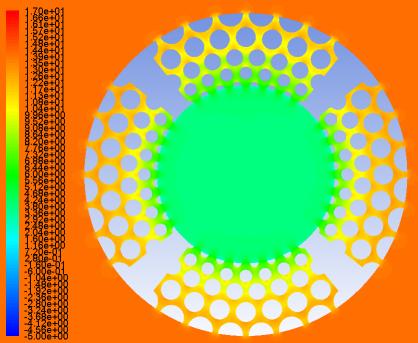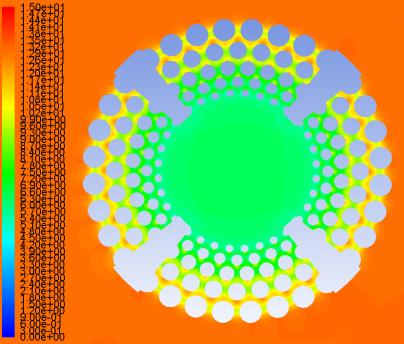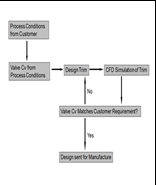Optimal design of flow handling systems using computational fluid dynamics
Submitting Institution
University of HuddersfieldUnit of Assessment
General EngineeringSummary Impact Type
TechnologicalResearch Subject Area(s)
Information and Computing Sciences: Artificial Intelligence and Image Processing
Engineering: Interdisciplinary Engineering
Summary of the impact
University of Huddersfield research into the optimal design of
flow-handling systems has been credited with "transforming" the
development strategies and global market sales of an industrial partner.
Weir Valves and Control Ltd has enjoyed a 75% saving in design lead time
and a 1,800% increase in annual sales - from several thousand before its
collaboration to millions in 2013 - through the structured integration of
researchers' computational fluid dynamics expertise in its design process.
The success of this collaboration, which has been described as an exemplar
of a Knowledge Transfer Partnership, has also led to further research
contracts.
Underpinning research
The innovative design of fluid systems is an important area of work for
the University of Huddersfield's Energy, Emissions and the Environment
Research Group (EEERG) which is a part of the Centre of Efficiency and
Performance Engineering. Novel methods in this field can have a number of
different yet related applications for a range of end-users. Professor
Rakesh Mishra (Senior Lecturer, 2004-2009; Reader, 2009-2011; Professor of
Engineering, 2011-present) has led EEERG's studies into flow through
complex geometries, including research carried out on various
fluid-handling systems.
In 2005, as part of an EPSRC New Academic CASE award in collaboration
with Bentley Motors, Mishra began research to develop an inverse design
code for brake discs for optimum flow and heat transfer characteristics.
These discs have embedded pin and aerofoil-shaped structures within the
flow passage to modify flow patterns and minimise judder and undesirable
vibrations. A systematic computational fluid dynamic (CFD) analysis and
experimental study resulted in the development of design equations
correlating flow characteristics with the geometry of the disc. These
equations were then embedded in the design methodology to develop an
inverse design code. This work resulted in several publications, including
two in the Proceedings of the Institute of Mechanical Engineers, Part D:
Automobile Engineering [1, 2].
Weir Valves and Controls Ltd, which uses similar features in control
valve applications, approached Mishra after becoming aware of his research
through these publications. This resulted in a three-year Knowledge
Transfer Partnership programme, approved by the Technology Strategy Board
and EPSRC, to address the company's need to embed complex flow knowledge
into its design, operation and sales teams. This research involved the
following objectives:
- Improved scientific understanding of flow geometry of valve bodies in
order to enhance valve performance and comply with IEC 60534 Part 2
sizing calculation standards
- Improved understanding of valve performance under compressible versus
incompressible flows
- Understanding the effects of multiphase flow (e.g. oil/water,
water/solids, oil/water/gas) and entrained solids on valve performance
- Understanding the effects of specific trim designs on flow
recirculation, vortex shedding and cavitation.
The work involved detailed CFD and experimental studies on the standard
valve trim to validate the CFD models. The strategy for CFD was based on
the published works [1, 2] and resulted in accurate estimates of design
parameters CV and K. It was apparent that the front-row cylinders were
responsible for the majority of the pressure loss. Areas of negative
pressure zone that were susceptible to cavitation were also identified
(Figure 1).
By manipulating the geometry it was possible to achieve controlled
reduction in pressure drop and minimise cavitation. The results obtained
through CFD tests were matched with a purpose-built valve test rig at the
University, and excellent matching between the two was observed. Outcomes
from CFD were then embedded in the design process, and a new strategy was
adopted (Figure 2). The work also included the development of special
software to simplify design and analysis.

 Figure 1: Effect of geometry modification on Pressure
Figure 1: Effect of geometry modification on Pressure
 Figure 2: Modified design strategy
Figure 2: Modified design strategy
References to the research
Publications:
1. E Palmer, R Mishra and J Fieldhouse (2008): `A Computational
Analysis on the Effect of Front-Row Pin Geometry on the Aero-Thermodynamic
Properties of a Pin-Vented Brake Disc', IMechE Journal Part D,
Volume 222, 1231-1245. DOI: 10.1243/09544070JAUTO755 (Downloaded 60 times
from the University Repository by users in 19 countries http://eprints.hud.ac.uk/4395/).
2. E Palmer, R Mishra and J Fieldhouse (2009): `An Optimisation
Study of a Multiple-Row Pin-Vented Brake Disc to Promote Brake Cooling
Using CFD', IMechE Journal Part D, Volume 223, Number 7, 865-875.
DOI: 10.1243/09544070JAUTO1053 (Downloaded 76 times from the University
Repository by users in 20 countries http://eprints.hud.ac.uk/4392/)
Grants:
EPSRC CASE award for New Academics, University of Huddersfield and
Bentley Motors, September 2005 to September 2009 - £78,000. PI Rakesh
Mishra.
Technology Strategy Board/EPSRC KTP award to University of Huddersfield
in association with Weir Valves and Controls Ltd, January 2011 to January
2014 - £120,000. PI Rakesh Mishra.
Details of the impact
EEERG's innovative work on fluid systems has been credited with
"transforming" the design, operating and sales strategies of one of the
University of Huddersfield's industrial partners. The successful
application of research, which has resulted in 18-fold increase in sales
for the company and further contracts for the University, has been
described as an exemplar of a Knowledge Transfer Partnership.
The inverse design methodology that was first developed for Bentley
Motors led to immediate success when incorporated into Weir Valves and
Controls Ltd's X-Stream valve trim. In its product literature the company,
based in Elland, West Yorkshire, describes X-Stream as "the first [valve]
of its kind to provide complete 3D-flow control", adding: "The result of
an extensive research programme, this method of design uses a combination
of proven computational fluid dynamics (CFD) and actual flow visualisation
techniques to eliminate local areas of excessive turbulence and velocity
(the main source of noise and erosion problems) and areas of recirculating
flow (a significant cause of cavitation)." [a] Modifications in design
strategy brought about by EEERG's research resulted in an immediate
improvement in design lead times - specifically, a reduction of 75% - and
led to growth in demand for and sales of X-Stream. In addition, enhanced
knowledge of the pressure field and the velocity field inside valve
internals enabled the company's design and sales employees to handle
clients' queries far more efficiently. [b, c]
The resulting success of this collaboration has led to more investment in
the company's R&D and sales strategies, including the establishing of
a team specifically tasked with handling X-Stream matters. The industrial
supervisor of the KTP was given responsibility for leading further
research and development in this area, with Mishra's team and the
University's facilities remaining integral to the work. The growth in
sales since the partnership was first established is reflected in the
figures below.
| Year: |
2010 |
2011 |
2012 |
2013 |
| Sales:* |
£X |
£4X |
£ 11 X |
£ 18 X |
(Actual numbers cannot be given because of confidentiality)
This progression shows how embedding the knowledge through the KTP
programme, along with initiatives taken by the company to fully utilise
the support available, has resulted in a 18-fold increase in sales in the
space of less than four years. [c] The figure for 2012-2013 is expected to
show a 25 fold increase by the end of this year. Weir's Senior Design
Engineer has remarked: "The impact of embedding outcomes of computational
fluid dynamics into the design strategy, as well as operation and sales,
transformed the market for X-Stream worldwide." [c] Speaking at a local
management committee meeting in September 2013, the KTP adviser described
the programme as an example of an ideal Knowledge Transfer Partnership in
which academic expertise had been embedded through a structured process in
the company's work system to deliver benefits to all parties. [d]
The strengthening of the partnership between the University and Weir as a
result of the success of EEERG's research has delivered further
advantages. In the past two years four graduates have been employed by the
company as full-time engineers, and every year Weir has employed two
placement students, which has further contributed to the partnership's
sustainability. Although the current KTP is due to end in January 2014,
both parties have already agreed to extend collaboration via another KTP -
one focused on extending the work carried out so far to develop the design
of wear-resistive valves for application in the oil and gas industry.
The influence of the research conducted with both Bentley and Weir has
also been be evidenced by the securing of further contracts by Mishra and
his team. Two PhD studentships are being sponsored by Blackhall
Engineering Ltd, of Brighouse, West Yorkshire, to embed the team's
knowledge base into the company's design and development activities in
order to optimise Blackhall's product range. [e]
Sources to corroborate the impact
a. Product description of X-Stream, Weir Valves and Controls Ltd
http://www.weirpowerindustrial.com/products__services/valve_products/control_valves/severe_service_control_valve-1.aspx
b. Support letter from Managing Director, Weir Valves and Controls Ltd
c. Support letter from Research and Development Lead Engineer, Weir
Valves and Controls Ltd
d. Support letter from the KTP Adviser, Technology Strategy Board
e. Studentship agreements signed by Managing Director, Blackhall
Engineering Ltd